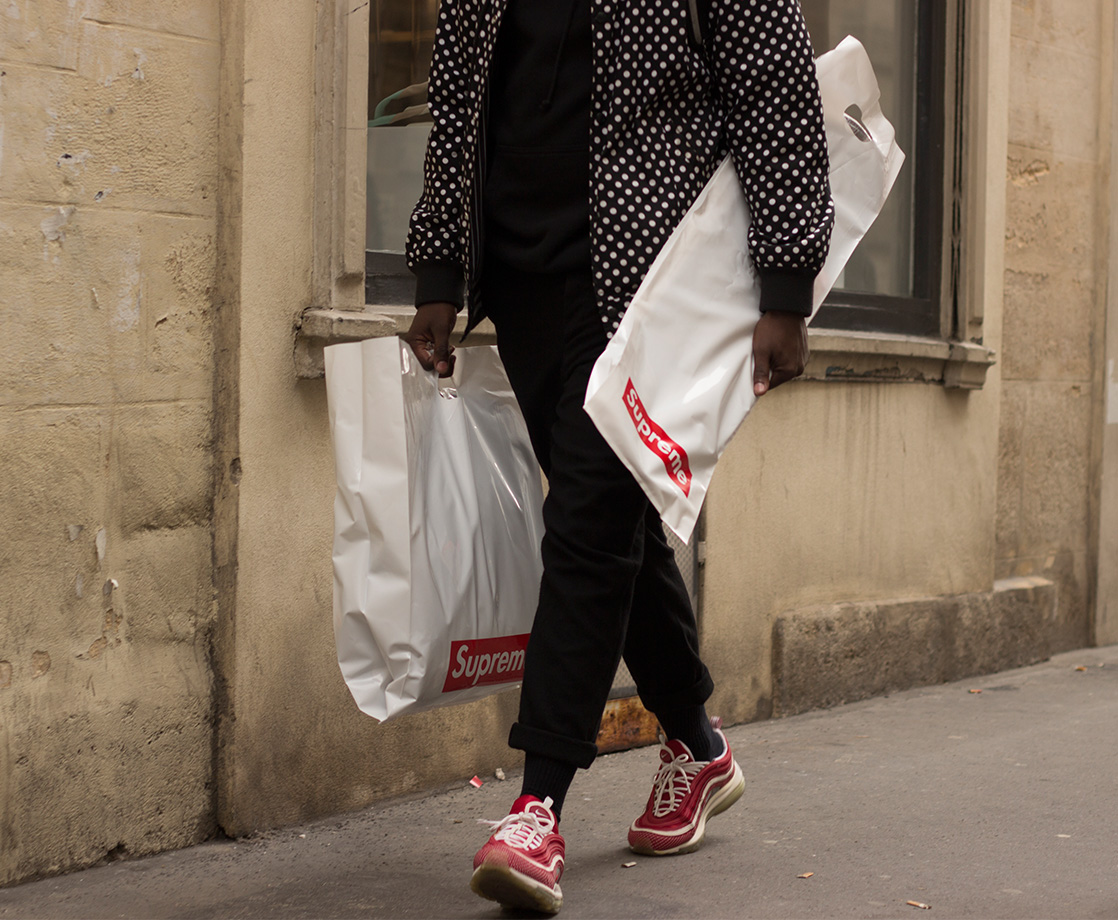All photos courtesy of Byron Hawes and powerHouse Books
The gorgeous cover of Byron Hawes' new photobook, Drop (out now via powerHouse Books), succinctly illustrates the booming streetwear industry. It is increasingly bougie and financially prohibitive, hence a wallet with a credit card visibly poking out. The brands that define the commodity-centric subculture are so revered that they can make a coveted "grail" out of anything — even a MetroCard, evinced by the Supreme-branded one pictured — simply by slapping their logo on it. And it is an international phenomenon bereft of borders, as suggested by a thick wad of money comprised of multiple currencies.
In fashion hubs from Paris to New York to Tokyo, streetwear heads line up around blocks for the chance to cop limited items at the latest "drop," a term for the launch of a new line by one of the revered brands. Supreme, Vetements, Off-White, VLONE — the degree to which you're familiar with or unaware of these names defines just how much of a hypebeast you are. A term inextricably linked to this world of momentum-driven pricing and looks, "hypebeast" was coined by a fashion and culture blog of the same name. The site's rise coincided with streetwear's own increase in popularity a little over ten years ago. Ever since, the scene's been cross-pollinating with the formerly impenetrable world of high fashion — Gucci, Versace, Louis Vuitton, and the like.
Hawes, an editor at Hypebeast and architectural designer whose projects have included building a recording studio and offices for Drake's OVO Sound label, expertly captures this ever-shifting scene in Drop. Save for one essay, he does this via glossy shots taken by various photographers at drops around the world. Swarms of mostly-teens peer out from behind pristine, hyper-limited apparel, wearing grails during their quests for more grails, aiming to impress their fellow hypebeasts more so than any potential romantic partners. The carefully-selected photos lend a sense of human connection to a hobby that can, with the proliferation of a lucrative streetwear reselling market, seem selfish, isolating, and disingenuous. But to the vast majority of kids in camo print, iconic brand stamps, and Yeezys, this is a way of life.
MERRY JANE caught up with Hawes over the phone to delve deeper into the culture and industry of streetwear. We talked purity, Kanye, brands' long-standing relevance, and of course, the evolution of the term "hypebeast."

MERRY JANE: Hey Byron, how did you start formulating the idea for this book?
Byron Hawes: It was actually all super random. I was walking down Lafayette with a homie, and we were walking by Supreme, and there were a bunch of people in line. My friend was like, 'Why are these kids waiting?' And I said, Part of it is that they want the stuff, but there's also kind of a cultural aspect to it. This is sort of like family for these people. They all go, they wear their grails, they nerd out. You know, nobody's buying this super limited stuff to try to get laid. They say women dress for each other, well these kids definitely dress for each other. There's a little one-upmanship, a little bit of peacocking.
So we're walking down the street, just having this conversation that's it's really interesting— it's almost some combination between a music festival and high fashion runway shows. It's fascinating. You'll see kids in these lines wearing pairs of shoes valued at $25,000. They'll keep them in a quiver, and brush them, and then they'll wear them just to stand in line in SoHo, and then take them back home and put them back in that vault. Then I emailed powerHouse, and like 20 minutes later, the founder of the company emailed back like, 'Yo, my kid fucking loves Supreme. Let's do it.'
When sorting through the photos that were submitted for this project, what criteria were you looking for?
One part of this was trying to show, through imagery, that feeling of the cultural camaraderie — these kids that stand in line out in the rain talking shit about the old Supreme shit they have in their parents' basement, and about which stuff they want to buy. I don't know how the fuck some of these kids have so much money. It blows my mind. But a lot of them, they can only get one thing, They're waiting in line the whole day, but they only have 60 bucks. They're 15-years-old, and they're just talking endlessly about how this shirt compares to that shirt. They're nerdy in a cool way.
And then some of the other photos we wanted to show different venues — you know, Beijing, Sydney, Seoul, Hong Kong, Paris, London, L.A., Miami. It's a very international thing, and if you're in that scene, you'll get a sense of the local aesthetic, how different people interpret it and make it their own. Like, you'll see the same jacket in the book on somebody in New York, somebody in Seoul, and then somebody in Paris, and the three individuals wear it very, very differently.

When you're talking about the international appeal of streetwear, what do you see as the common thread, other than the specific pieces of apparel these kids are wearing?
The internet has really shrunk the world. You often find that you have way more in common with some Belgian dentist you've never met, but you've talked online about some movie or some shoe more than you do with your next-door neighbor. I live in New York City; I don't even know any of my neighbors. But there's mad people you talk to around the world and you get the sense that these kids take it really seriously. They really, genuinely care about it. It's interesting to see how someone in Paris will wear something differently than someone somewhere else, but at the end of the day, the aesthetics and the cultural key-forms that go along with it — there's a uniformity to that.
You hear lots of older people talk about how the internet's disconnected us from each other, but do you find that the opposite to be mostly true in streetwear culture?
On the one hand, every now and again I go on little rant complaining that now all you have to do is have enough of your dad's money and you can buy any piece. We used to really wait in line, like go to other cities and wait in line, and you'd have to know about it. That aspect has changed quite a lot, but in another sense, it's really brought people from around the world together.

You wrote that one of the book's main missions is to "catch a glimpse of the pureness" of streetwear culture. Is that something that's harder to find in the wake of that increased access?
It's easy to say that there's less purity there because there's definitely so many resellers — I know kids in New York that make six figures a year and all they do is buy Supreme shit and sell it to other people. That's their living. But although a lot of the kids are new, just because you came to something late doesn't mean that you don't have love for it — that's a pretty fucking common misconception from the OGs. Like, 'You weren't there back in '95!' Like, 'Yeah, my dude, I was negative four. Give me a break.'
I think with the hype comes fakery and impure motivations. The shoes Virgil Abloh did with Nike went insanely fast, and then all of the sudden they're $4,000 on resellers. But I've met a lot of young kids— 18, 19, 20-years-old — and they will scrimp and save and hustle their asses off to get these shoes, and then they just fucking wear them. At the end of the day, they're like, 'Yo, it's a shoe.' I have so much respect when I see a kid wearing some limited Air Maxes down at the corner pizza joint. That's what it's supposed to be about. I don't think there's less purity, I think the impurity is more obvious and getting more attention. It's also tougher to get a hold of absolutely everything, but that's partly because there's just more people interested in it. A guy who buys a pair of shoes that you want isn't necessarily a reseller.

Is there a lot of animosity towards resellers? I'm more familiar with vinyl culture, where people gripe about those who flip super limited pressings, but it seems like more people make a living off of it in streetwear.
Totally. In fact, I have a friend who's on tour right now with [Canadian R&B singer] Daniel Caesar, and we were actually just having that same conversation. He just saw an original pressing of Wu-Tang's Enter the 36 Chambers for $300, and was like, 'Fuck off.' There are definitely people who are super upset about that in the streetwear world, without a shadow of a doubt. I can understand that. To an extent, it's disingenuous, and I certainly don't do it.
I know lots of the people in the industry so I can get my hands on pretty much anything, and if I don't really want something, even if I could get a hold of it, I don't do it because I personally can't contribute to that culture of flipping things and making them commodities rather than culture. Commodifying culture's a dangerous thing. That said, with the kids who are flipping the stuff to make a living, they're gonna be there whether you complain or not, so what's the point? A hustle is a hustle. If somebody can make a buck, somebody's gonna try to make a buck. My one-man protest is to just wear all the shit.

I was surprised at how many photos in the book feature Yeezys or Life of Pablo merch. To the average teenage kid, do you think Kanye's still hugely influential in terms of streetwear?
Yeah, it's actually crazy just how influential the man is. I was blown away when he did that first collection with APC — I thought that was interesting, but I have to admit, I did not see it blowing up the way it did. It has just been a rocket ship to the moon, the way the Yeezy brand has grown. It's been really impressive. People can say whatever negative thing they want to about him — he is brilliant… [Brief pause] Sorry, a kid actually just sat down right beside me wearing Yeezy Boosts.
Wow, that's too perfect.
Yeah, and they're the ones that are valued at like 5K. That's funny, perfect symmetry. But yeah, it's pretty extraordinary how much influence Kanye's had. And then somebody like Pharrell, whose style is a lot of haute couture fashion stuff, like Vivienne Westwood's Smokey the Bear hat, all the stuff he's done with Lagerfeld — these kids have definitely in no small way shaped in this world. And down to the youngsters like Travis $cott, Young Thug…
For me, it's wild that Kanye's maintained this much relevance, not just in music, but in fashion. There are kids who are 16, 17, and they may be listening to Playboi Carti or whoever, but they're rocking Yeezys. That kind of longevity is rare.
It's extraordinary. You can say whatever you want to say about Kanye, but when it comes to production, dude is a fucking monster. He's just more powerful than everyone else. I'm with you, I think it's interesting that he's managed to stay so excruciatingly relevant, and is TMZ's wet dream. Everything he does is the biggest news ever.

How do all these brands manage to stay hot year after year?
I genuinely believe that in the next few years, the Wharton business school will start doing a class on Supreme's marketing techniques, because I don't think any company has ever done better. They sell $40 t-shirts, and they become the most sought-after thing in the game. That's impressive — nobody does that. Especially because they've basically been doing the same thing for forever. They switch it up a little bit, but there's still that idea like, 'Fuck it, we're Supreme.'
Do you think it's that attitude and insistence on staying true to the original vision that's the main secret to their continued success?
The attitude definitely doesn't hurt. I don't know if you spend a lot of time with them or go to many of their shops, but especially back in the day, they had rules that you couldn't touch anything, and you could only buy one thing, or two things, or things in your own size. It shocks you deeply when you go into the store, and you'll see some tourists go in and pick up a t-shirt off the shelf, and an employee will go, 'Yo, fuck you, don't fucking touch that.' And it's like Whoa, damn, seriously?
Just two weeks ago, I was in a shop in Brooklyn and there was this Chinese tourist, and he was trying to buy like five of one t-shirt. And the Supreme guy was like, 'Nah motherfucker, you can buy one.' And the tourist was like, 'But I want to buy five.' And the dude was like, 'You know what? You can't have anything, get out.' It's like damn, the customer's clearly not always right.

Have any of their drops been considered complete flops?
It's interesting, there's this weird almost sixth sense about what stuff is going to be the thing. It's not like everyone's talking like, 'This is the thing I want,' but all of us can just tell. Like when that folding chair came out, I could tell that wasn't really going to sell that well because people weren't stoked about it. Whereas when they do something with North Face, everybody knows that that's going to be the jam. They also target different segments. When they did the Public Enemy collection, a lot of the young heads were like, 'I don't really fuck with that.' But then the people who have been around for a hot second were like, 'Damn, Fear of a Black Planet tour merch 30 years later? Let me get in on that.'
With your history writing for Hypebeast and use of the word "hypebeast" in your Drop essay, what's your opinion of the term? Do you think it's derogatory or often misused?
Like many other slang terms, people can use it in different ways. I've heard people be like, 'Oh, he's such a fucking hypebeast.' I even I have good friends who are high up at Hypebeast who use that term derogatorily, which I think is hilarious because it's like, You're the editor of 'Hypebeast.'
You can also use it the same way that the girls in Mean Girls say, 'That's so fetch.' Like, Oh, that's so fucking hypebeast. In that sense, it's a negative term. But then you'll see people who just deadass use it to describe themselves. I saw this kid online yesterday who described himself as a 'Chinese Hypebeast.' A friend of mine was like, 'Do you know this dude, does he work for Hypebeast in China?' And I was like, 'He doesn't work for Hypebeast, he's straight up calling himself a hypebeast.'
And with the site, they're so big. I don't know if you've seen their numbers, but they get, like, 40 times the readership of GQ or something. They're a fucking behemoth. It's mental, they're a shoe blog that IPO'd for more than a quarter of a billion dollars. I think a big part of their initial success was just coining the term — it' a brilliant name, once you hear it, you can never fucking forget it.

You mentioning GQ kind of brings us full circle, because Drop really illuminates the destratification of the streetwear and high fashion worlds. What do you think are the most surprising and/or important outcomes of the destruction of that barrier between those industries?
I think it's both negative and positive. I find it sometimes completely ridiculous that it drives up the price for certain things. It shocks me that some of these running shoes that are by small, street-level brands are now priced like Gucci stuff. I mean, I've bought some of this stuff too, but the price point of something by Gucci is typically like that because they use materials that are pretty luxe. Not to mention, they spend a billion dollars a year on ads in Vogue and other fashion glossies, so I get it. But the fact that some of these t-shirts are $1000 from some one-man show in Berlin boggles my mind.
But realistically, that decompartmentalization of high and street fashion has been pretty extraordinary. To see someone like Virgil Abloh taking over Louis Vuitton's menswear side — he's a black dude from Chicago, he's trained as an architect, he's not even trained in fashion, he started in the hip-hop world working for Kanye, started a small streetwear line, then a larger one, and ended up taking over one of the most successful brands in the world. That's a pretty clear manifestation of the fact that there's pretty much no delineation between street and high-end fashion.
I also think that, realistically, the way people dress has become much more casual over the years. Every time I go out with a blazer on, people are like, 'Oh, where are you going today?' Like, Nowhere special? But yeah, I think we're going to see the divisions between levels of fashion continue to go away. You know, Balenciaga's making running shoes, and Off-White's making dresses, and it's going to keep going that way.


Buy Byron Hawes' "Drop" from powerHouse Books.
Follow Patrick Lyons on Twitter.











